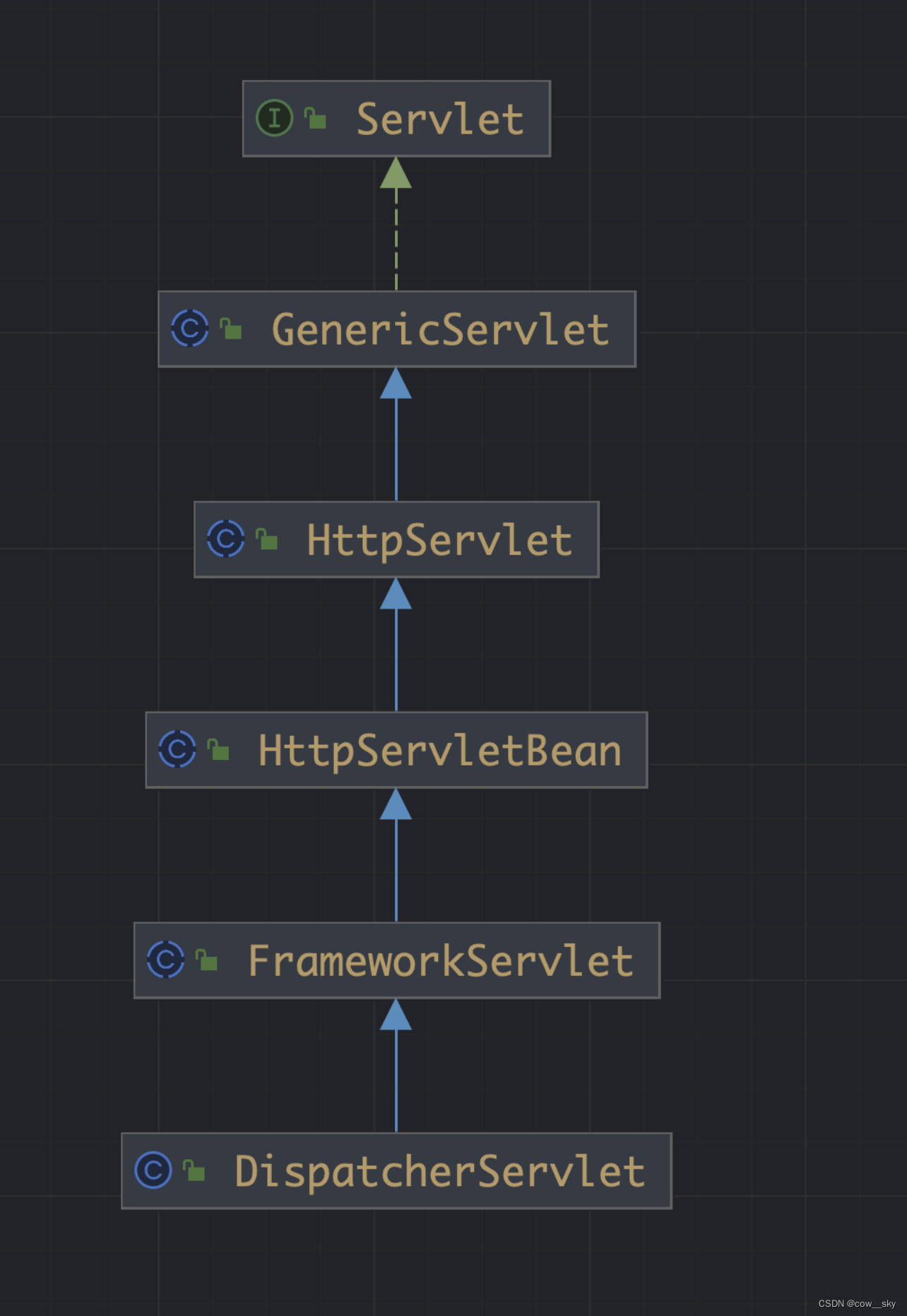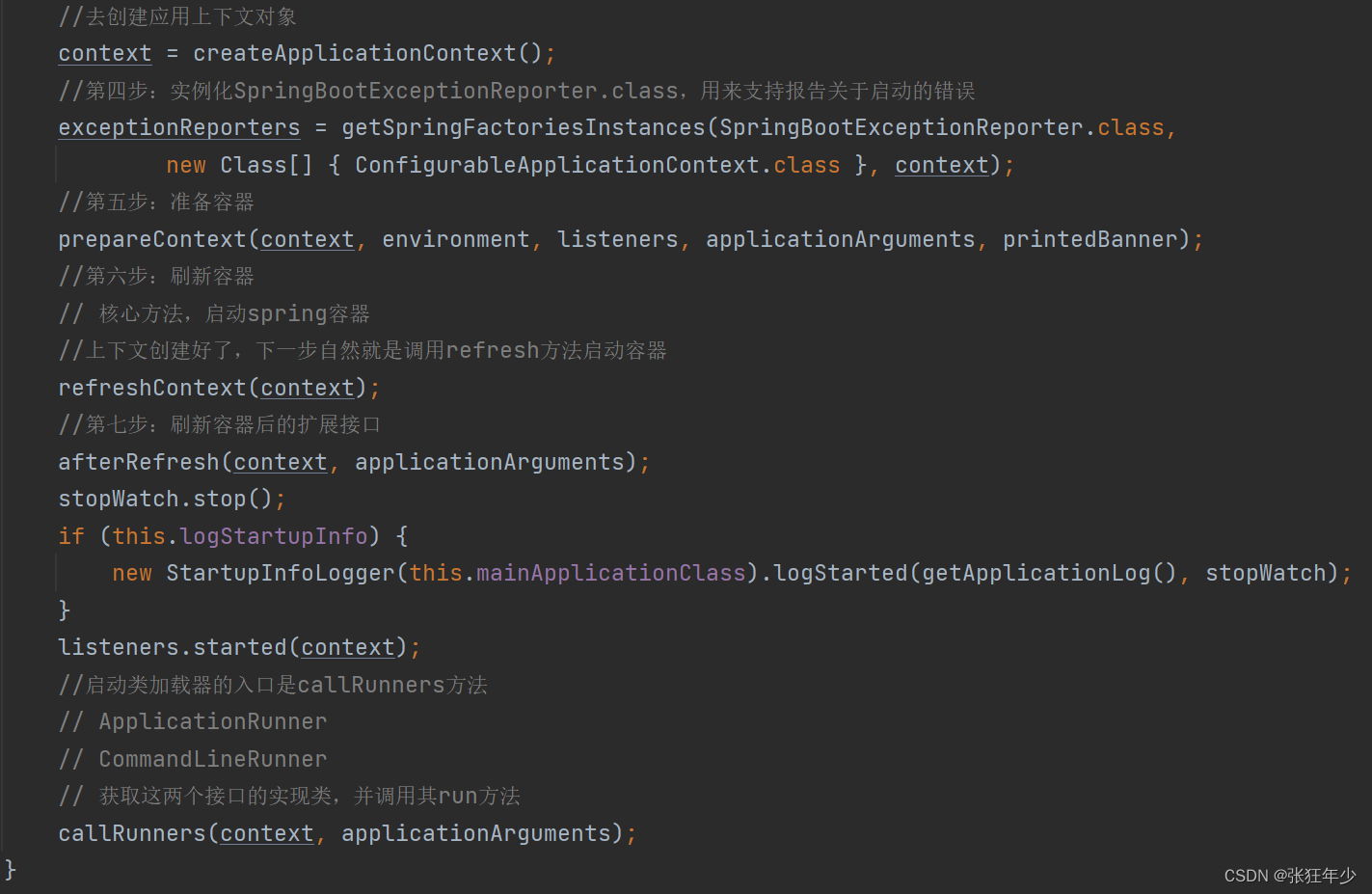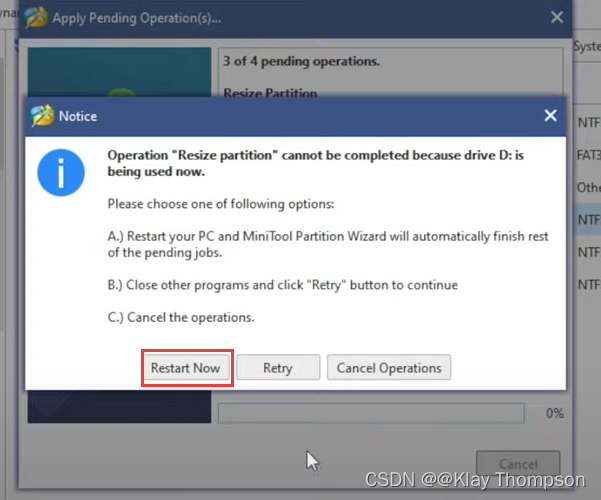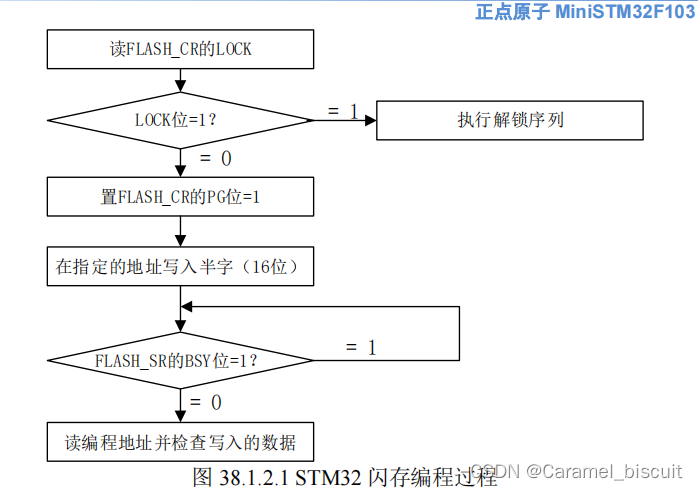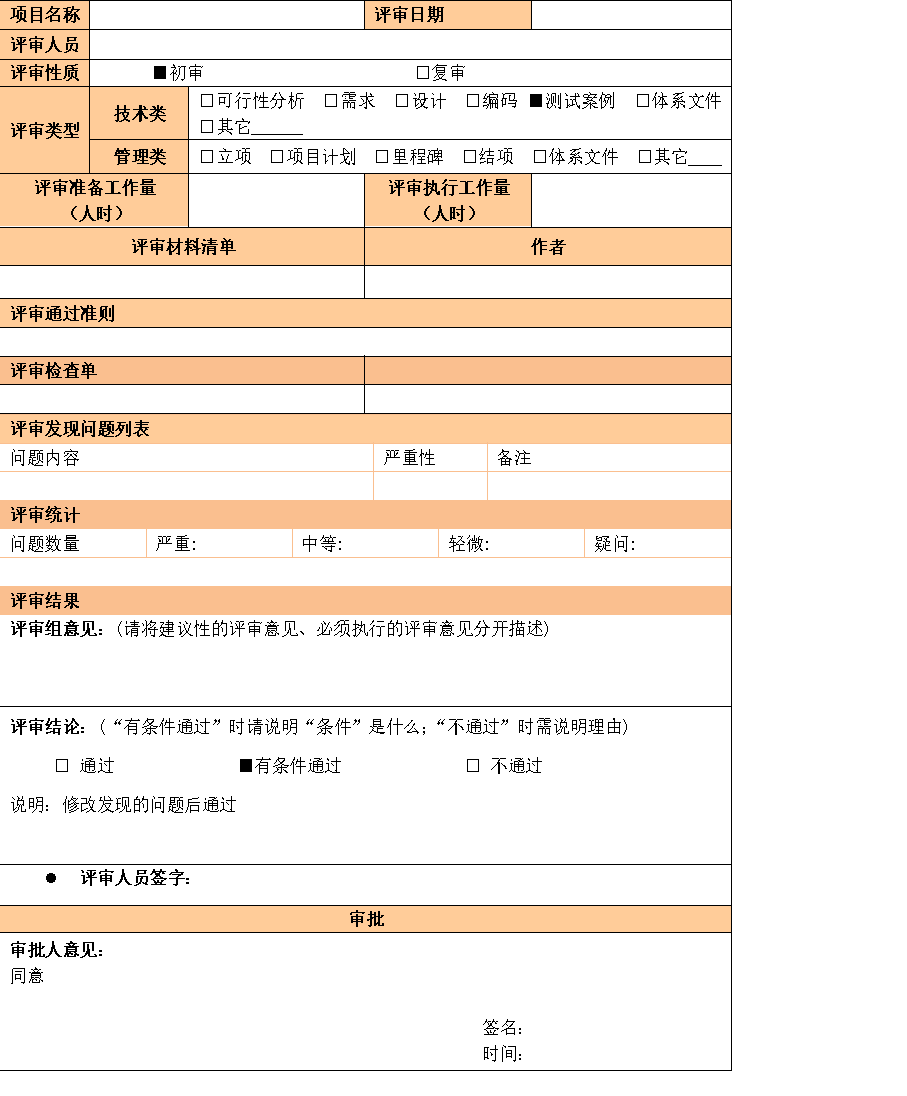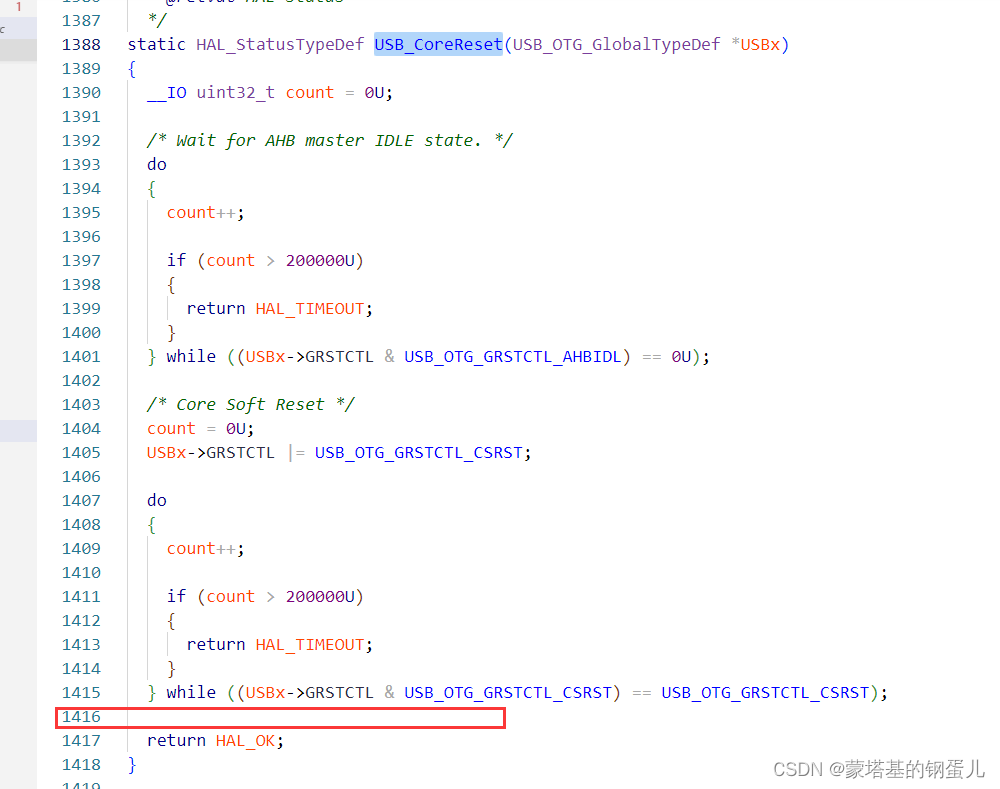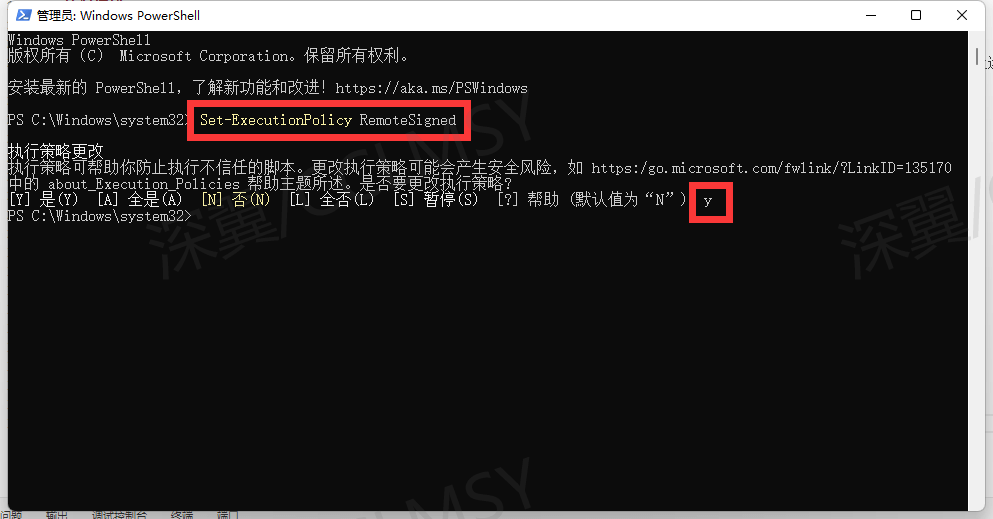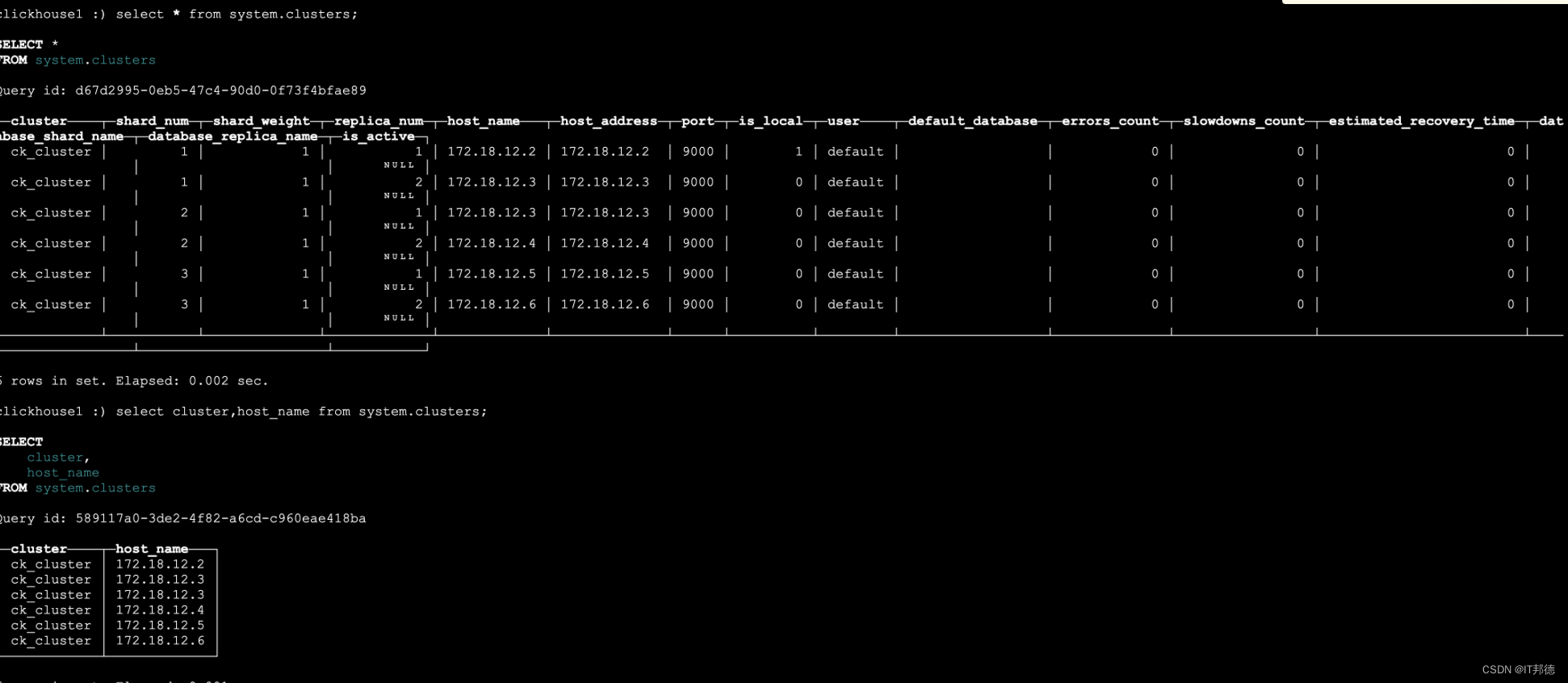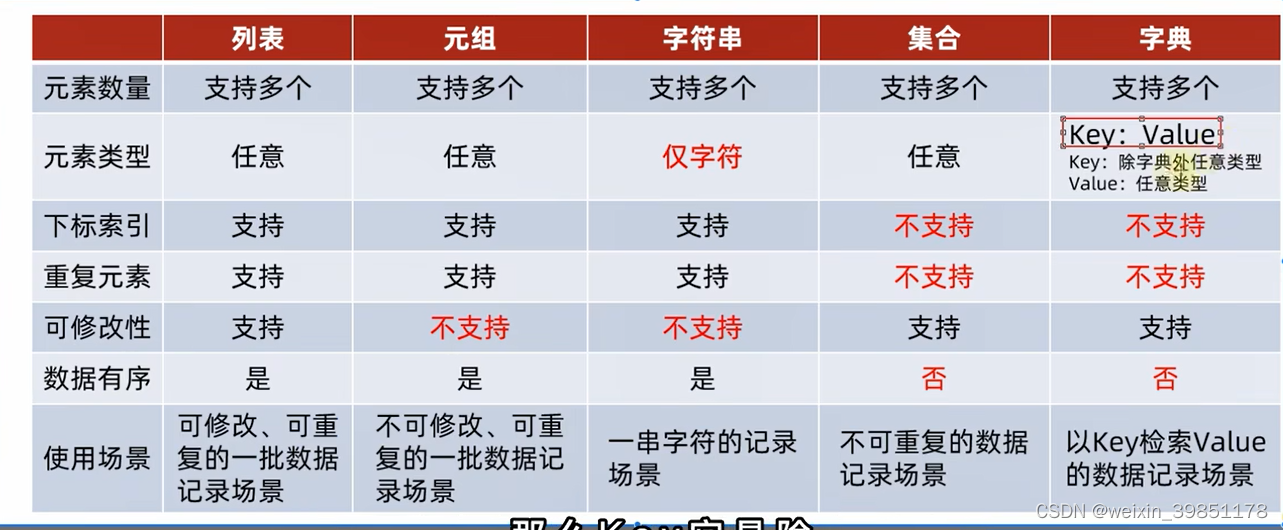写在前面
哥,来帮我看看,这个请求怎么404了,明明接口路径是对的啊!一个下午,组里的小哥突然让我帮忙看这个问题,我不禁一惊,啥,这年头了还有人搞不定404,如有还有,那一定是没看完这篇文章!
一、为何要写这篇文章
作为一名crud工程师,咱们的工作真的就只剩增删改查了吗?在笔者所遇到各类从事软件开发的人群中,工作1-2年甚至3-5年的,在遇到404这类的http异常code时都显得束手无策,经验稍微丰富的点“老”手可能凭经验能看出问题出在哪里,但是又有多少人知道为什么会出现404 code,往深了说,又有多少人知道一个http请求是如何找到controller中的方法并执行呢?更进一步,在你了解到spring mvc 的处理机制前,如果让你来设计这套流程,你会怎么做?
二、举个例子
下面是一个最简单的http接口例子
接口路径为 /api/common/getNumber
@RequestMapping("/api/common")
@Controller
public class CommonController {
@RequestMapping("/getNumber")
@ResponseBody
public Object getNumberMethod(@RequestParam("range") Integer range) {
return ThreadLocalRandom.current().nextInt(range);
}
}过滤器
public class LogFilter implements Filter {
@Override
public void init(FilterConfig filterConfig) {
}
@Override
public void doFilter(ServletRequest servletRequest, ServletResponse servletResponse, FilterChain filterChain) throws IOException, ServletException {
HttpServletRequest request = (HttpServletRequest) servletRequest;
log.info("经过logFilter ==== {}", request);
filterChain.doFilter(servletRequest, servletResponse);
}
@Override
public void destroy() {
}
}拦截器
public class LogInterceptor extends HandlerInterceptorAdapter {
@Override
public boolean preHandle(HttpServletRequest request, HttpServletResponse response, Object handler) throws Exception {
log.info("经过拦截器 === {}", request);
return true;
}
}执行结果
2023-10-03 19:22:12.373 INFO 54072 --- [nio-8080-exec-1] o.a.c.c.C.[Tomcat].[localhost].[/] : Initializing Spring DispatcherServlet 'dispatcherServlet'
2023-10-03 19:22:12.373 INFO 54072 --- [nio-8080-exec-1] o.s.web.servlet.DispatcherServlet : Initializing Servlet 'dispatcherServlet'
2023-10-03 19:22:15.646 INFO 54072 --- [nio-8080-exec-1] o.s.web.servlet.DispatcherServlet : Completed initialization in 3273 ms
2023-10-03 19:22:19.759 INFO 54072 --- [nio-8080-exec-1] com.example.demo.filter.LogFilter : 经过logFilter ==== org.apache.catalina.connector.RequestFacade@67d0b80a
2023-10-03 19:22:26.177 INFO 54072 --- [nio-8080-exec-1] c.e.demo.intercpetor.LogInterceptor : 经过拦截器 === org.apache.catalina.connector.RequestFacade@67d0b80a三、执行过程
1、运行环境
jdk 1.8
spring-boot-starter-parent 2.1.9.RELEASE
spring-webmvc 5.1.0
2、源码解析
在进行源码解析时,我们先过一眼整个请求处理的过程UML图
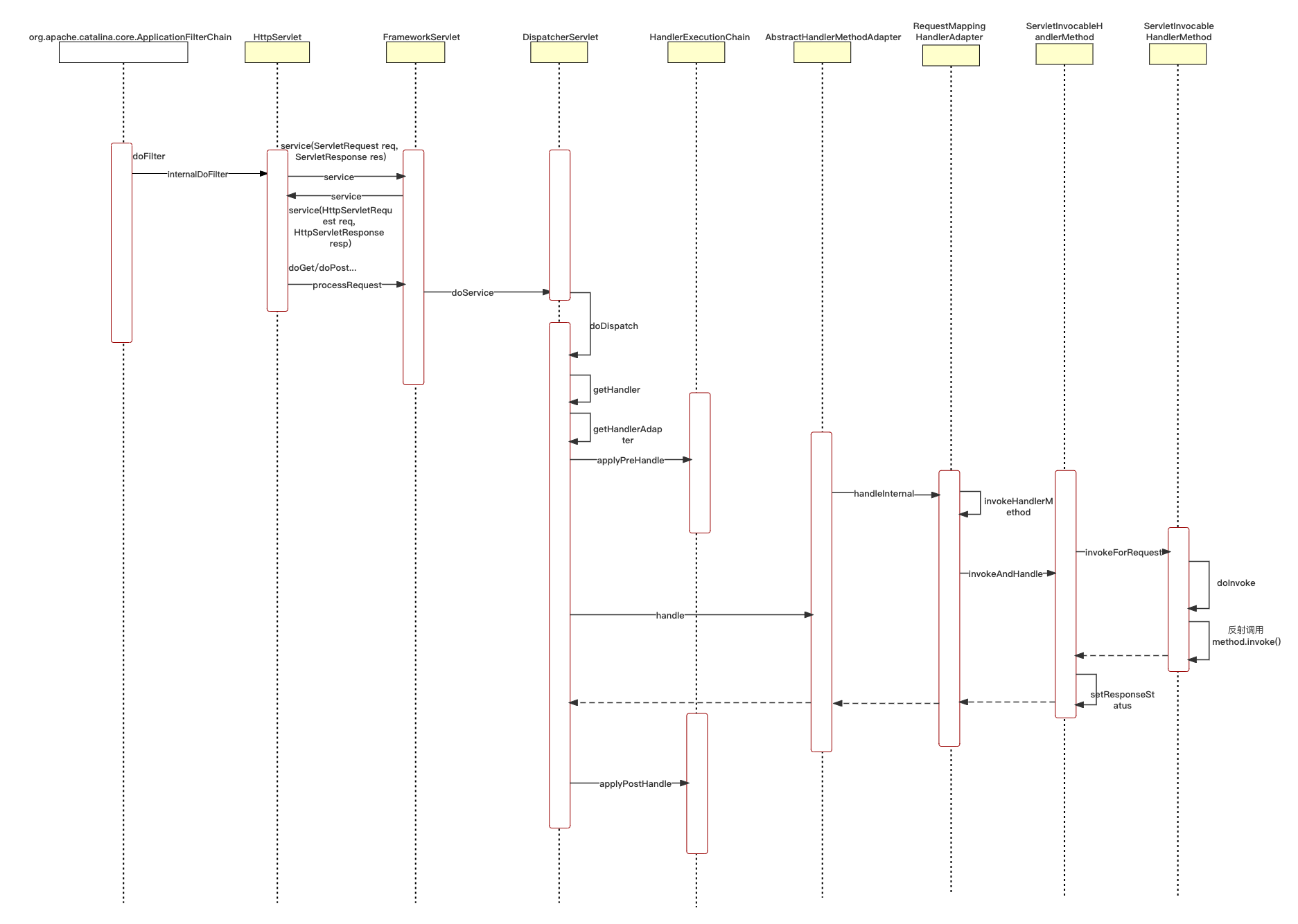
0)ApplicationFilterChain # internalDoFilter(ServletRequest request, ServletResponse response)
该方法是tomcat包中的方法,用来执行filter,在filter执行完成后再执行servlet.service方法,而servlet.service方法也是业务的入口方法。servlet对象即为DispatchServlet,其service对应的也就是其父类HttpServlet的service方法。
private void internalDoFilter(ServletRequest request,
ServletResponse response)
throws IOException, ServletException {
// n 表示filter数的总和,pos表示当前位置
// Call the next filter if there is one
if (pos < n) { // 如果filter没有执行完成,则走下面的逻辑继续执行
// 获取pos位置对应的filterConfig,同时将pos+1
ApplicationFilterConfig filterConfig = filters[pos++];
try {
Filter filter = filterConfig.getFilter();
if (request.isAsyncSupported() && "false".equalsIgnoreCase(
filterConfig.getFilterDef().getAsyncSupported())) {
request.setAttribute(Globals.ASYNC_SUPPORTED_ATTR, Boolean.FALSE);
}
if( Globals.IS_SECURITY_ENABLED ) {
final ServletRequest req = request;
final ServletResponse res = response;
Principal principal =
((HttpServletRequest) req).getUserPrincipal();
Object[] args = new Object[]{req, res, this};
SecurityUtil.doAsPrivilege ("doFilter", filter, classType, args, principal);
} else {
// 执行具体的filter逻辑,如本文例子中的LogFilter
filter.doFilter(request, response, this);
}
} catch (IOException | ServletException | RuntimeException e) {
throw e;
} catch (Throwable e) {
e = ExceptionUtils.unwrapInvocationTargetException(e);
ExceptionUtils.handleThrowable(e);
throw new ServletException(sm.getString("filterChain.filter"), e);
}
return;
}
// We fell off the end of the chain -- call the servlet instance
// 如果执行完最后一个filter
try {
if (ApplicationDispatcher.WRAP_SAME_OBJECT) {
lastServicedRequest.set(request);
lastServicedResponse.set(response);
}
if (request.isAsyncSupported() && !servletSupportsAsync) {
request.setAttribute(Globals.ASYNC_SUPPORTED_ATTR,
Boolean.FALSE);
}
// Use potentially wrapped request from this point
if ((request instanceof HttpServletRequest) &&
(response instanceof HttpServletResponse) &&
Globals.IS_SECURITY_ENABLED ) {
final ServletRequest req = request;
final ServletResponse res = response;
Principal principal =
((HttpServletRequest) req).getUserPrincipal();
Object[] args = new Object[]{req, res};
SecurityUtil.doAsPrivilege("service",
servlet,
classTypeUsedInService,
args,
principal);
} else {
// 执行HttpServlet的service方法
servlet.service(request, response);
}
} catch (IOException | ServletException | RuntimeException e) {
throw e;
} catch (Throwable e) {
e = ExceptionUtils.unwrapInvocationTargetException(e);
ExceptionUtils.handleThrowable(e);
throw new ServletException(sm.getString("filterChain.servlet"), e);
} finally {
if (ApplicationDispatcher.WRAP_SAME_OBJECT) {
lastServicedRequest.set(null);
lastServicedResponse.set(null);
}
}
}1)FrameworkServlet # service(HttpServletRequest request, HttpServletResponse response)
由于HttpServlet的service方法只是做了入参的转换,即将ServletRequest转成HttpServletRequest,ServletResponse转成HttpServletResponse,参数转换完后随即调用了子类 FrameworkServlet 的service(HttpServletRequest request, HttpServletResponse response) 方法,而FrameworkServlet 的service方法功能很简单,就是为了适配httpMethod 中的 PATCH模式,非PATCH模式直接走父类HttpServlet的service(HttpServletRequest request, HttpServletResponse response)方法【DispatcherServlet的继承关系依赖图如下】。
/**
* Override the parent class implementation in order to intercept PATCH requests.
* 主要是为了拦截 httpMethod 中的 PATCH
*
* patch是2010后成为的正式http方法,详见RFC5789,
* 它是对put的补充,在没有patch之前,我们都是用put进行更新操作,
* 这时候我们的接口中通常会有一个逻辑规则,如:如果对象的的一个字符属性为NULL,
* 那么就是不更新该属性(字段)值,如果对象的字符属性是“”,那么就更新该属性(字段)的值,
* 通过这种方式来避免全部覆盖的操作。现在有了patch就解决了这种判断,在put接口中不管属性是不是null,
* 都进行更新,在patch接口中就对非null的进行更新
*
*/
@Override
protected void service(HttpServletRequest request, HttpServletResponse response)
throws ServletException, IOException {
HttpMethod httpMethod = HttpMethod.resolve(request.getMethod());
// 如果是 HttpMethod.PATCH 或者 找不到httpMethod
if (httpMethod == HttpMethod.PATCH || httpMethod == null) {
processRequest(request, response);
}
else {
// 其他情况则调用父类也就是HttpServlet的service方法,
// 在这里,由于我们的请求是get类型的,所以会走到此分支
super.service(request, response);
}
}2)HttpServlet # service(HttpServletRequest req, HttpServletResponse resp)
进入HttpServlet的service(HttpServletRequest req, HttpServletResponse resp)方法后,该方法主要做了method类型的区分调用,即get post put等对应的doGet,doPost,doPut 由子类实现。
/**
* Receives standard HTTP requests from the public
* <code>service</code> method and dispatches
* them to the <code>do</code><i>Method</i> methods defined in
* this class. This method is an HTTP-specific version of the
* {@link javax.servlet.Servlet#service} method. There's no
* need to override this method.
*
* @param req the {@link HttpServletRequest} object that
* contains the request the client made of
* the servlet
*
* @param resp the {@link HttpServletResponse} object that
* contains the response the servlet returns
* to the client
*
* @exception IOException if an input or output error occurs
* while the servlet is handling the
* HTTP request
*
* @exception ServletException if the HTTP request
* cannot be handled
*
* @see javax.servlet.Servlet#service
*/
protected void service(HttpServletRequest req, HttpServletResponse resp)
throws ServletException, IOException {
String method = req.getMethod();
if (method.equals(METHOD_GET)) {
// 默认返回 -1
long lastModified = getLastModified(req);
if (lastModified == -1) {
// servlet doesn't support if-modified-since, no reason
// to go through further expensive logic
doGet(req, resp);
} else {
long ifModifiedSince;
try {
ifModifiedSince = req.getDateHeader(HEADER_IFMODSINCE);
} catch (IllegalArgumentException iae) {
// Invalid date header - proceed as if none was set
ifModifiedSince = -1;
}
if (ifModifiedSince < (lastModified / 1000 * 1000)) {
// If the servlet mod time is later, call doGet()
// Round down to the nearest second for a proper compare
// A ifModifiedSince of -1 will always be less
maybeSetLastModified(resp, lastModified);
doGet(req, resp);
} else {
resp.setStatus(HttpServletResponse.SC_NOT_MODIFIED);
}
}
} else if (method.equals(METHOD_HEAD)) {
long lastModified = getLastModified(req);
maybeSetLastModified(resp, lastModified);
doHead(req, resp);
} else if (method.equals(METHOD_POST)) {
doPost(req, resp);
} else if (method.equals(METHOD_PUT)) {
doPut(req, resp);
} else if (method.equals(METHOD_DELETE)) {
doDelete(req, resp);
} else if (method.equals(METHOD_OPTIONS)) {
doOptions(req,resp);
} else if (method.equals(METHOD_TRACE)) {
doTrace(req,resp);
} else {
//
// Note that this means NO servlet supports whatever
// method was requested, anywhere on this server.
//
String errMsg = lStrings.getString("http.method_not_implemented");
Object[] errArgs = new Object[1];
errArgs[0] = method;
errMsg = MessageFormat.format(errMsg, errArgs);
resp.sendError(HttpServletResponse.SC_NOT_IMPLEMENTED, errMsg);
}
}3)DispatcherServlet # doDispatch(HttpServletRequest request, HttpServletResponse response)
HttpServlet的service(HttpServletRequest req, HttpServletResponse resp)方法经过一连串的包装调用后就会进入最重要的DispatcherServlet 的 doDispatch(HttpServletRequest request, HttpServletResponse response)方法,doDispatch顾名思义就是将请求进行分发,包括获取HandlerExecutionChain,执行拦截器,获取执行器适配器,handler调用,视图渲染等工作。
/**
* Process the actual dispatching to the handler.
* <p>The handler will be obtained by applying the servlet's HandlerMappings in order.
* The HandlerAdapter will be obtained by querying the servlet's installed HandlerAdapters
* to find the first that supports the handler class.
* <p>All HTTP methods are handled by this method. It's up to HandlerAdapters or handlers
* themselves to decide which methods are acceptable.
* @param request current HTTP request
* @param response current HTTP response
* @throws Exception in case of any kind of processing failure
*/
protected void doDispatch(HttpServletRequest request, HttpServletResponse response) throws Exception {
HttpServletRequest processedRequest = request;
HandlerExecutionChain mappedHandler = null;
boolean multipartRequestParsed = false;
WebAsyncManager asyncManager = WebAsyncUtils.getAsyncManager(request);
try {
ModelAndView mv = null;
Exception dispatchException = null;
try {
processedRequest = checkMultipart(request);
multipartRequestParsed = (processedRequest != request);
// Determine handler for the current request.
// 该方法得到一个 HandlerExecutionChain 处理器执行链,实际上它包含了一个真正的处理handler
// 和 若干个拦截器
mappedHandler = getHandler(processedRequest);
if (mappedHandler == null) {
noHandlerFound(processedRequest, response);
return;
}
// Determine handler adapter for the current request.
// 获取执行器适配器
HandlerAdapter ha = getHandlerAdapter(mappedHandler.getHandler());
// Process last-modified header, if supported by the handler.
String method = request.getMethod();
boolean isGet = "GET".equals(method);
if (isGet || "HEAD".equals(method)) {
long lastModified = ha.getLastModified(request, mappedHandler.getHandler());
if (new ServletWebRequest(request, response).checkNotModified(lastModified) && isGet) {
return;
}
}
// 执行拦截器的preHandle方法,如果拦截了则直接返回
if (!mappedHandler.applyPreHandle(processedRequest, response)) {
return;
}
// Actually invoke the handler.
// 真正调用handler
mv = ha.handle(processedRequest, response, mappedHandler.getHandler());
if (asyncManager.isConcurrentHandlingStarted()) {
return;
}
applyDefaultViewName(processedRequest, mv);
// 执行拦截器的 postHandle 方法
mappedHandler.applyPostHandle(processedRequest, response, mv);
}
catch (Exception ex) {
dispatchException = ex;
}
catch (Throwable err) {
// As of 4.3, we're processing Errors thrown from handler methods as well,
// making them available for @ExceptionHandler methods and other scenarios.
dispatchException = new NestedServletException("Handler dispatch failed", err);
}
// 处理视图的方法,将逻辑视图转为物理视图的过程,同时执行拦截器的afterCompletion方法
processDispatchResult(processedRequest, response, mappedHandler, mv, dispatchException);
}
catch (Exception ex) {
// 执行拦截器的afterCompletion方法
triggerAfterCompletion(processedRequest, response, mappedHandler, ex);
}
catch (Throwable err) {
triggerAfterCompletion(processedRequest, response, mappedHandler,
new NestedServletException("Handler processing failed", err));
}
finally {
if (asyncManager.isConcurrentHandlingStarted()) {
// Instead of postHandle and afterCompletion
if (mappedHandler != null) {
mappedHandler.applyAfterConcurrentHandlingStarted(processedRequest, response);
}
}
else {
// Clean up any resources used by a multipart request.
if (multipartRequestParsed) {
cleanupMultipart(processedRequest);
}
}
}
}a. DispatcherServlet # getHandler(HttpServletRequest request)
该方法得到一个 HandlerExecutionChain 处理器执行链,实际上它包含了一个真正的处理handler和 若干个拦截器
/**
* Return the HandlerExecutionChain for this request.
* <p>Tries all handler mappings in order.
* @param request current HTTP request
* @return the HandlerExecutionChain, or {@code null} if no handler could be found
*/
@Nullable
protected HandlerExecutionChain getHandler(HttpServletRequest request) throws Exception {
if (this.handlerMappings != null) {
for (HandlerMapping mapping : this.handlerMappings) {
HandlerExecutionChain handler = mapping.getHandler(request);
if (handler != null) {
return handler;
}
}
}
return null;
}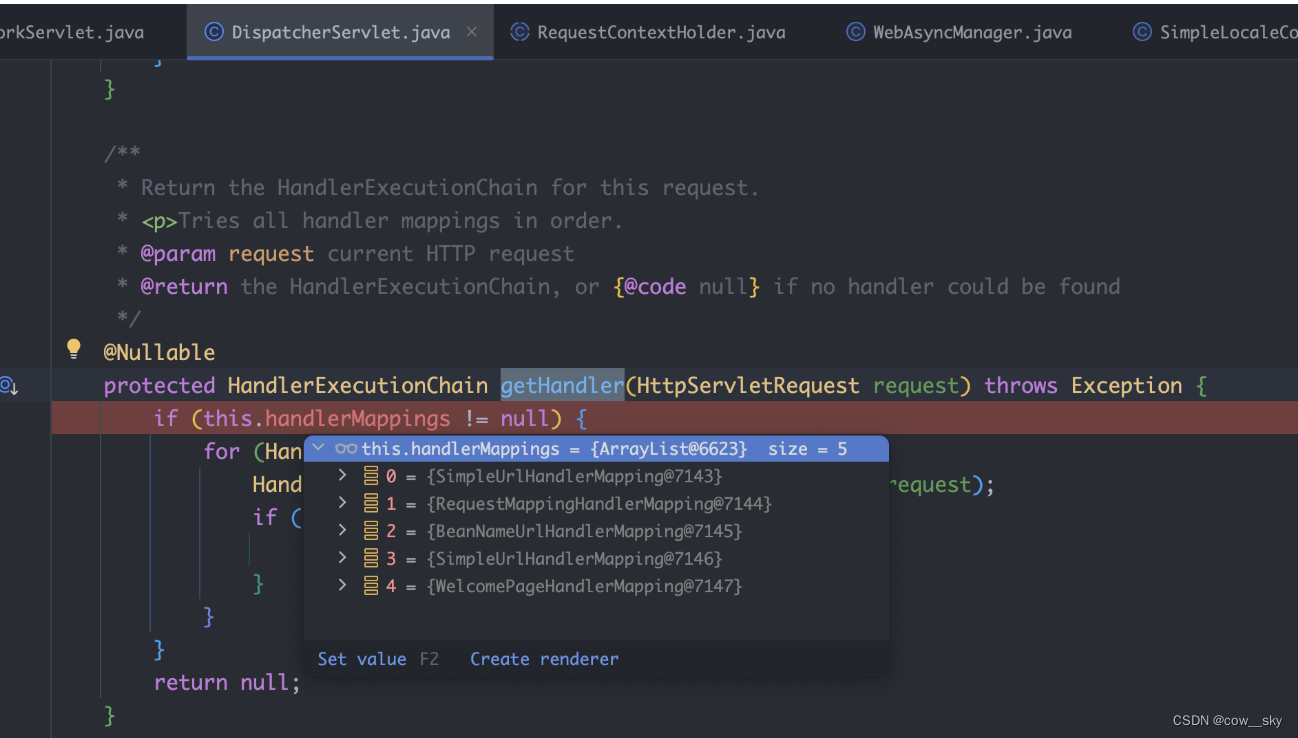
从上图执行过程中可以看出,HandlerExecutionChain的获取主要依赖于HandlerMapping ,那么何为HandlerMapping?HandlerMapping 称为处理器映射器,

从HandlerMapping的继承关系图中可以看出,HandlerMapping可以大致分为 AbstractHandlerMethodMapping 和 AbstractUrlHandlerMapping 两大类,其中AbstractHandlerMethodMapping 映射器主要处理用 @Controller 和 @RequestMapping 这样注解来描述视图控制器的逻辑,也是我们日常开发中用的最多的场景;而AbstractUrlHandlerMapping用的比较少,比如:<mvc:view-controller path="" view-name=""/> 标签配置资源不经过视图控制器直接跳转就用到了 SimpleUrlHandlerMapping 这种映射器。
当执行 HandlerExecutionChain handler = mapping.getHandler(request); 时,会跳到 AbstractHandlerMapping类,执行getHandler方法,AbstractHandlerMapping 是个抽象类,提供了模板方法,主要的功能在代码块getHandlerInternal方法,在本例中getHandlerInternal的功能主要就是根据request来获取HandlerMethod,HandlerMethod对象存储于MappingRegistry的mappingLookup<T, HandlerMethod>映射表中,该映射表在容器启动时,探测类上是否有Controller或者RequestMapping注解修饰,如有则生成RequestMappingInfo到HandlerMethod的映射关系。
/**
* Look up a handler for the given request, falling back to the default
* handler if no specific one is found.
* @param request current HTTP request
* @return the corresponding handler instance, or the default handler
* @see #getHandlerInternal
*/
@Override
@Nullable
public final HandlerExecutionChain getHandler(HttpServletRequest request) throws Exception {
// 重要, 本例中返回 HandlerMethod 对象,该对象里面包含了目标类的目标method信息以及目标类的bean
Object handler = getHandlerInternal(request);
if (handler == null) {
handler = getDefaultHandler();
}
if (handler == null) {
return null;
}
// Bean name or resolved handler?
if (handler instanceof String) {
String handlerName = (String) handler;
handler = obtainApplicationContext().getBean(handlerName);
}
// 将 handler(本例中对应的是HandlerMethod 对象)以及拦截器信息封装到 HandlerExecutionChain 链中
HandlerExecutionChain executionChain = getHandlerExecutionChain(handler, request);
if (logger.isTraceEnabled()) {
logger.trace("Mapped to " + handler);
}
else if (logger.isDebugEnabled() && !request.getDispatcherType().equals(DispatcherType.ASYNC)) {
logger.debug("Mapped to " + executionChain.getHandler());
}
if (CorsUtils.isCorsRequest(request)) {
CorsConfiguration globalConfig = this.corsConfigurationSource.getCorsConfiguration(request);
CorsConfiguration handlerConfig = getCorsConfiguration(handler, request);
CorsConfiguration config = (globalConfig != null ? globalConfig.combine(handlerConfig) : handlerConfig);
executionChain = getCorsHandlerExecutionChain(request, executionChain, config);
}
return executionChain;
}b. DispatcherServlet # getHandlerAdapter(Object handler)
该方法是获取处理器适配器,那么为什么要有处理器适配器,直接执行handler不行吗?原因就是处理器 handler 的类型是 Object 类型。Spring 中的handler实现多变,比如用户的处理器可以实现 Controller 接口或者 HttpRequestHandler 接口,也可以用 @RequestMapping 注解将方法作为一个处理器等,这就导致 Spring MVC 无法直接执行这个处理器。所以这里需要一个处理器适配器,由它去执行处理。获取处理器适配的方法寥寥数语,最主要的逻辑就是 adapter.supports(handler),根据语句猜测大概就是根据条件匹配对应的适配器。在我们弄清楚这个逻辑前,先来看看第一条语句if (this.handlerAdapters != null),那么这个this.handlerAdapters 的值从哪里来?
/**
* Return the HandlerAdapter for this handler object.
* @param handler the handler object to find an adapter for
* @throws ServletException if no HandlerAdapter can be found for the handler. This is a fatal error.
*/
protected HandlerAdapter getHandlerAdapter(Object handler) throws ServletException {
if (this.handlerAdapters != null) {
for (HandlerAdapter adapter : this.handlerAdapters) {
if (adapter.supports(handler)) {
return adapter;
}
}
}
throw new ServletException("No adapter for handler [" + handler +
"]: The DispatcherServlet configuration needs to include a HandlerAdapter that supports this handler");
}根据下图的执行过程可以看出,有三个满足条件的handlerAdapter。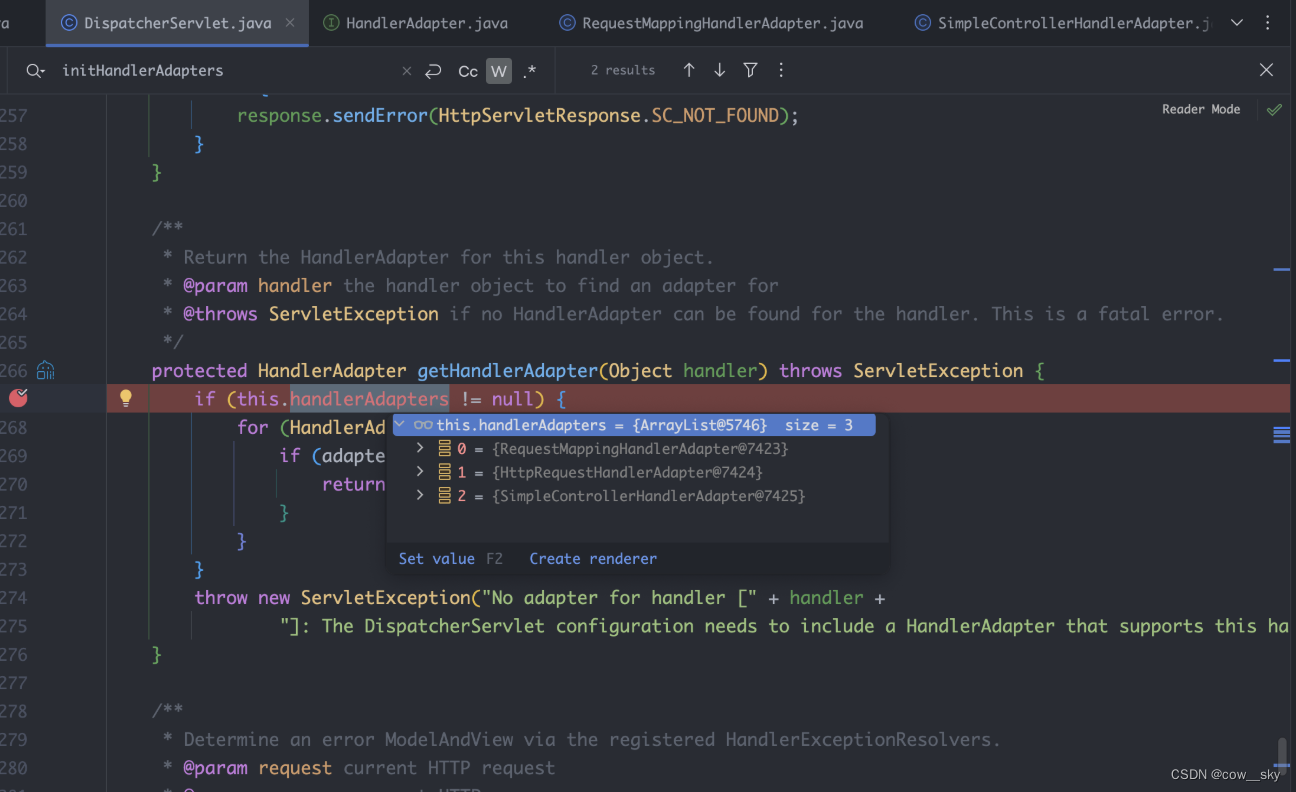
那么,这三个handlerAdapter是如何确定的呢?如下:
/**
* Initialize the HandlerAdapters used by this class.
* <p>If no HandlerAdapter beans are defined in the BeanFactory for this namespace,
* we default to SimpleControllerHandlerAdapter.
*/
private void initHandlerAdapters(ApplicationContext context) {
this.handlerAdapters = null;
if (this.detectAllHandlerAdapters) {
// Find all HandlerAdapters in the ApplicationContext, including ancestor contexts.
Map<String, HandlerAdapter> matchingBeans =
BeanFactoryUtils.beansOfTypeIncludingAncestors(context, HandlerAdapter.class, true, false);
if (!matchingBeans.isEmpty()) {
this.handlerAdapters = new ArrayList<>(matchingBeans.values());
// We keep HandlerAdapters in sorted order.
AnnotationAwareOrderComparator.sort(this.handlerAdapters);
}
}
else {
try {
HandlerAdapter ha = context.getBean(HANDLER_ADAPTER_BEAN_NAME, HandlerAdapter.class);
this.handlerAdapters = Collections.singletonList(ha);
}
catch (NoSuchBeanDefinitionException ex) {
// Ignore, we'll add a default HandlerAdapter later.
}
}
// Ensure we have at least some HandlerAdapters, by registering
// default HandlerAdapters if no other adapters are found.
if (this.handlerAdapters == null) {
this.handlerAdapters = getDefaultStrategies(context, HandlerAdapter.class);
if (logger.isTraceEnabled()) {
logger.trace("No HandlerAdapters declared for servlet '" + getServletName() +
"': using default strategies from DispatcherServlet.properties");
}
}
}上述代码的大体含义如下:
-
如果“开启”探测功能,则扫描已注册的 HandlerAdapter 的 Bean 们,添加到
handlerAdapters中,默认 开启 ,这里会进行排序,可以通过实现 Order 接口设置排序值 -
如果“关闭”探测功能,则获得 Bean 名称为 "handlerAdapter" 对应的 Bean ,将其添加至
handlerAdapters -
如果未获得到,则获得默认配置的 HandlerAdapter 类,调用
getDefaultStrategies(ApplicationContext context, Class<T> strategyInterface)方法,就是从DispatcherServlet.properties文件中读取 HandlerAdapter 的默认实现类,如下:
那么回到getHandlerAdapter方法中的adapter.supports(handler)语句,依次通过boolean supports(Object handler)方法判断使用哪个adapter。HandlerAdapter即采用适配器模式, 用于统一不同handler的接口调用。在本文例子中,最后采用的是RequestMappingHandlerAdapter,其对应的supports方法是
/**
* This implementation expects the handler to be an {@link HandlerMethod}.
* @param handler the handler instance to check
* @return whether or not this adapter can adapt the given handler
*/
@Override
public final boolean supports(Object handler) {
return (handler instanceof HandlerMethod && supportsInternal((HandlerMethod) handler));
}/**
* Always return {@code true} since any method argument and return value
* type will be processed in some way. A method argument not recognized
* by any HandlerMethodArgumentResolver is interpreted as a request parameter
* if it is a simple type, or as a model attribute otherwise. A return value
* not recognized by any HandlerMethodReturnValueHandler will be interpreted
* as a model attribute.
*/
@Override
protected boolean supportsInternal(HandlerMethod handlerMethod) {
return true;
}c. AbstractHandlerMethodAdapter # handle(HttpServletRequest request, HttpServletResponse response, Object handler)
该方法就是最终要执行业务方法,也就是Controller类中的某个方法的入口。
/**
* This implementation expects the handler to be an {@link HandlerMethod}.
*/
@Override
@Nullable
public final ModelAndView handle(HttpServletRequest request, HttpServletResponse response, Object handler)
throws Exception {
return handleInternal(request, response, (HandlerMethod) handler);
}handleInternal 方法依赖于子类的实现
@Override
protected ModelAndView handleInternal(HttpServletRequest request,
HttpServletResponse response, HandlerMethod handlerMethod) throws Exception {
ModelAndView mav;
checkRequest(request);
// Execute invokeHandlerMethod in synchronized block if required.
if (this.synchronizeOnSession) {
HttpSession session = request.getSession(false);
if (session != null) {
Object mutex = WebUtils.getSessionMutex(session);
synchronized (mutex) {
mav = invokeHandlerMethod(request, response, handlerMethod);
}
}
else {
// No HttpSession available -> no mutex necessary
mav = invokeHandlerMethod(request, response, handlerMethod);
}
}
else {
// No synchronization on session demanded at all...
mav = invokeHandlerMethod(request, response, handlerMethod);
}
if (!response.containsHeader(HEADER_CACHE_CONTROL)) {
if (getSessionAttributesHandler(handlerMethod).hasSessionAttributes()) {
applyCacheSeconds(response, this.cacheSecondsForSessionAttributeHandlers);
}
else {
prepareResponse(response);
}
}
return mav;
}在以上方法中,我们只需要关注invokeHandlerMethod(request, response, handlerMethod) 即可,接着看:
/**
* Invoke the {@link RequestMapping} handler method preparing a {@link ModelAndView}
* if view resolution is required.
* @since 4.2
* @see #createInvocableHandlerMethod(HandlerMethod)
*/
@Nullable
protected ModelAndView invokeHandlerMethod(HttpServletRequest request,
HttpServletResponse response, HandlerMethod handlerMethod) throws Exception {
ServletWebRequest webRequest = new ServletWebRequest(request, response);
try {
WebDataBinderFactory binderFactory = getDataBinderFactory(handlerMethod);
ModelFactory modelFactory = getModelFactory(handlerMethod, binderFactory);
ServletInvocableHandlerMethod invocableMethod = createInvocableHandlerMethod(handlerMethod);
.... 省去若干代码
// 只需关注这行即可
invocableMethod.invokeAndHandle(webRequest, mavContainer);
if (asyncManager.isConcurrentHandlingStarted()) {
return null;
}
return getModelAndView(mavContainer, modelFactory, webRequest);
}
finally {
webRequest.requestCompleted();
}
} /**
* Invoke the method and handle the return value through one of the
* configured {@link HandlerMethodReturnValueHandler HandlerMethodReturnValueHandlers}.
* @param webRequest the current request
* @param mavContainer the ModelAndViewContainer for this request
* @param providedArgs "given" arguments matched by type (not resolved)
*/
public void invokeAndHandle(ServletWebRequest webRequest, ModelAndViewContainer mavContainer,
Object... providedArgs) throws Exception {
// 实际调用
Object returnValue = invokeForRequest(webRequest, mavContainer, providedArgs);
// 处理结果状态值
setResponseStatus(webRequest);
if (returnValue == null) {
if (isRequestNotModified(webRequest) || getResponseStatus() != null || mavContainer.isRequestHandled()) {
disableContentCachingIfNecessary(webRequest);
mavContainer.setRequestHandled(true);
return;
}
}
else if (StringUtils.hasText(getResponseStatusReason())) {
mavContainer.setRequestHandled(true);
return;
}
mavContainer.setRequestHandled(false);
Assert.state(this.returnValueHandlers != null, "No return value handlers");
try {
// 处理返回值
this.returnValueHandlers.handleReturnValue(
returnValue, getReturnValueType(returnValue), mavContainer, webRequest);
}
catch (Exception ex) {
if (logger.isTraceEnabled()) {
logger.trace(formatErrorForReturnValue(returnValue), ex);
}
throw ex;
}
}/**
* Invoke the method after resolving its argument values in the context of the given request.
* <p>Argument values are commonly resolved through
* {@link HandlerMethodArgumentResolver HandlerMethodArgumentResolvers}.
* The {@code providedArgs} parameter however may supply argument values to be used directly,
* i.e. without argument resolution. Examples of provided argument values include a
* {@link WebDataBinder}, a {@link SessionStatus}, or a thrown exception instance.
* Provided argument values are checked before argument resolvers.
* <p>Delegates to {@link #getMethodArgumentValues} and calls {@link #doInvoke} with the
* resolved arguments.
* @param request the current request
* @param mavContainer the ModelAndViewContainer for this request
* @param providedArgs "given" arguments matched by type, not resolved
* @return the raw value returned by the invoked method
* @throws Exception raised if no suitable argument resolver can be found,
* or if the method raised an exception
* @see #getMethodArgumentValues
* @see #doInvoke
*/
@Nullable
public Object invokeForRequest(NativeWebRequest request, @Nullable ModelAndViewContainer mavContainer,
Object... providedArgs) throws Exception {
// 解析参数值
Object[] args = getMethodArgumentValues(request, mavContainer, providedArgs);
if (logger.isTraceEnabled()) {
logger.trace("Arguments: " + Arrays.toString(args));
}
// 执行调用
return doInvoke(args);
}/**
* Invoke the handler method with the given argument values.
*/
@Nullable
protected Object doInvoke(Object... args) throws Exception {
// 改变方法的可见性,这就是为什么即使controller中的方法是private的也能正常访问
ReflectionUtils.makeAccessible(getBridgedMethod());
try {
// 这就是精髓所在,熟悉的配方,熟悉的味道,这不就是反射调用吗!!!
return getBridgedMethod().invoke(getBean(), args);
}
catch (IllegalArgumentException ex) {
assertTargetBean(getBridgedMethod(), getBean(), args);
String text = (ex.getMessage() != null ? ex.getMessage() : "Illegal argument");
throw new IllegalStateException(formatInvokeError(text, args), ex);
}
catch (InvocationTargetException ex) {
// Unwrap for HandlerExceptionResolvers ...
Throwable targetException = ex.getTargetException();
if (targetException instanceof RuntimeException) {
throw (RuntimeException) targetException;
}
else if (targetException instanceof Error) {
throw (Error) targetException;
}
else if (targetException instanceof Exception) {
throw (Exception) targetException;
}
else {
throw new IllegalStateException(formatInvokeError("Invocation failure", args), targetException);
}
}
}d. DispatchServlet # processDispatchResult
对于某些接口需要渲染ModelAndView的,需要在下面这个方法里处理,例如,有个接口采用的是thymeleaf模板引擎来渲染接口数据。如下例子
@RequestMapping("/testHtml")
public String testHtml(Map<String, Object> map) {
map.put("msg","<h1>Hello,SpringBoot</h1>");
map.put("users", Arrays.asList("zhangsan","lisi"));
return "testHtml";
}<!DOCTYPE html>
<html lang="en" xmlns:th="http://www.thymeleaf.org">
<head>
<meta charset="UTF-8">
<title>测试</title></head>
<body><h1>测试页面</h1>
<div th:text="${msg}"></div>
<div th:utext="${msg}"></div>
<h4 th:each="user :${users}"
th:text="${user}">
</h4>
</body>
</html>效果如下: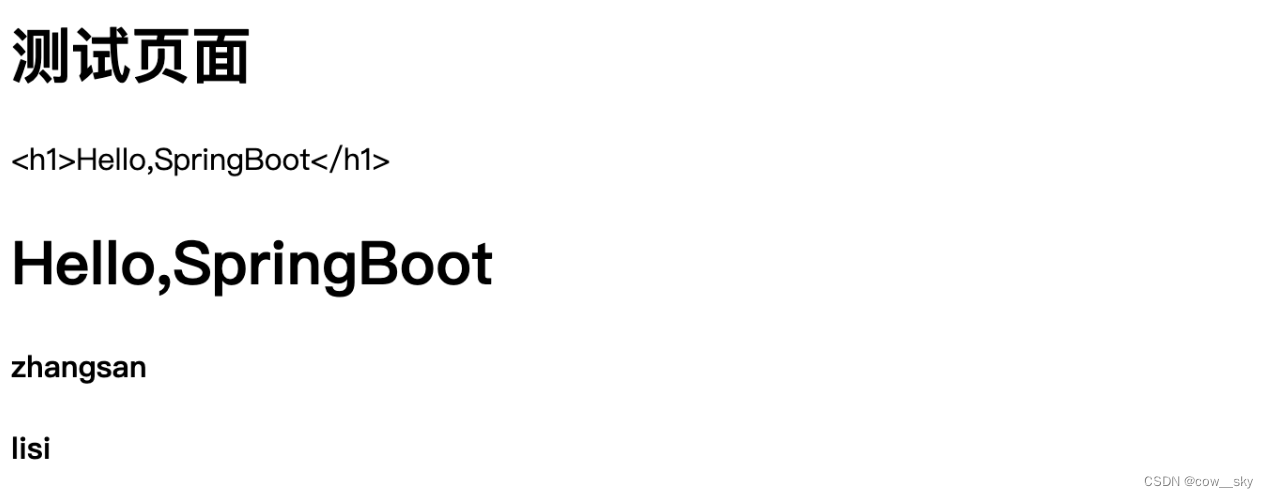
针对上面这个例子,执行完testHtml方法后,拿到返回的ModelAndView对象后执行下面processDispatchResult中的render方法渲染页面信息
/**
* Handle the result of handler selection and handler invocation, which is
* either a ModelAndView or an Exception to be resolved to a ModelAndView.
*/
private void processDispatchResult(HttpServletRequest request, HttpServletResponse response,
@Nullable HandlerExecutionChain mappedHandler, @Nullable ModelAndView mv,
@Nullable Exception exception) throws Exception {
boolean errorView = false;
... 省略若干代码
// Did the handler return a view to render?
if (mv != null && !mv.wasCleared()) {
// 渲染 ModelAndView
render(mv, request, response);
if (errorView) {
WebUtils.clearErrorRequestAttributes(request);
}
}
else {
if (logger.isTraceEnabled()) {
logger.trace("No view rendering, null ModelAndView returned.");
}
}
if (WebAsyncUtils.getAsyncManager(request).isConcurrentHandlingStarted()) {
// Concurrent handling started during a forward
return;
}
if (mappedHandler != null) {
// 执行拦截器的afterCompletion方法
mappedHandler.triggerAfterCompletion(request, response, null);
}
}从下图中可以看到 mv = ha.handle(processedRequest, response, mappedHandler.getHandler()); 返回的是mv 非空,说明有对应的ModelAndView需要渲染。

3、总结
从以上的执行过程来看,一个完整的http get 请求大概会经过执行 filter、从HandlerMapping中获取HandlerExecutionChain,HandlerExecutionChain里面包含了一个真正的处理handler(HandlerMethod,HandlerMethod包含了要执行方法的method信息以及类实例对象) 和若干个拦截器interceptors,然后根据handler获取对应的HandlerAdapter去执行,在执行过程中通过反射机制调用对应Controller的方法拿到结果,拿到结果后进行返回值的回写以及页面的渲染(如果有必要),在执行过程的前后会分别执行接口的拦截器preHandle以及postHandle方法。
那么,这整个过程的示意图如下
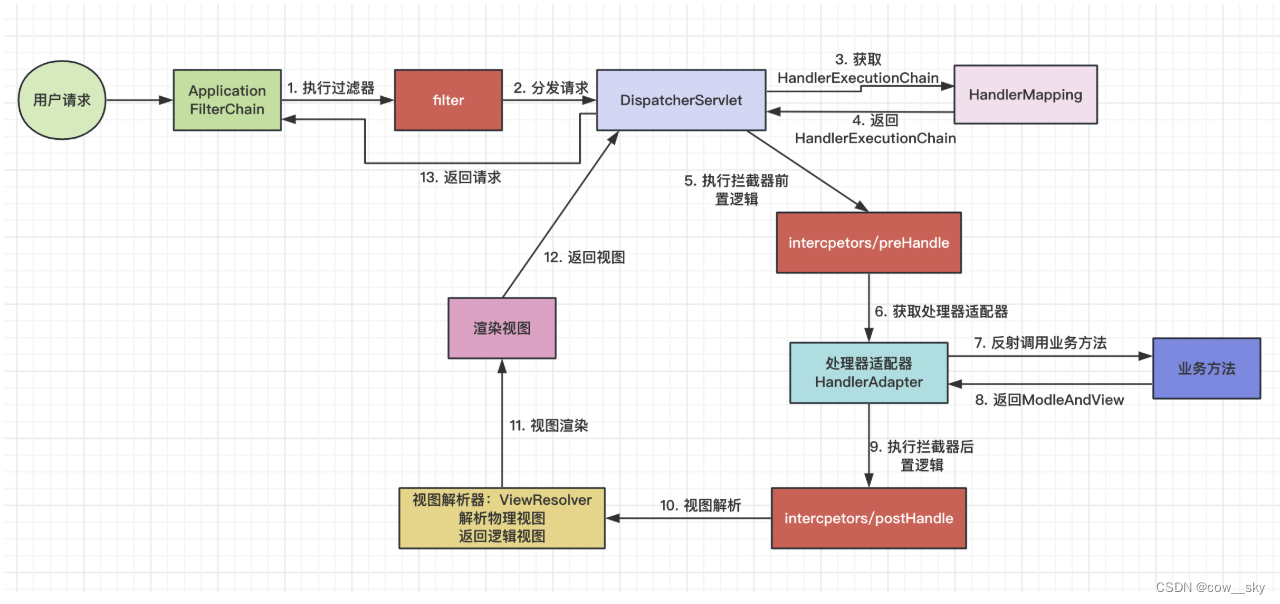
四、用到的技术点
1、设计模式
1) 模版模式 HandlerMapping

比如 HandlerMapping的实现抽象类AbstractHandlerMapping中有个getHanlder 方法,其中getHandlerInternal定义了模版方法,具体由子类实现
/**
* Look up a handler for the given request, falling back to the default
* handler if no specific one is found.
* @param request current HTTP request
* @return the corresponding handler instance, or the default handler
* @see #getHandlerInternal
*/
@Override
@Nullable
public final HandlerExecutionChain getHandler(HttpServletRequest request) throws Exception {
// 该方法则是模版方法,具体由子类实现
Object handler = getHandlerInternal(request);
if (handler == null) {
handler = getDefaultHandler();
}
if (handler == null) {
return null;
}
// Bean name or resolved handler?
if (handler instanceof String) {
String handlerName = (String) handler;
handler = obtainApplicationContext().getBean(handlerName);
}
HandlerExecutionChain executionChain = getHandlerExecutionChain(handler, request);
if (logger.isTraceEnabled()) {
logger.trace("Mapped to " + handler);
}
else if (logger.isDebugEnabled() && !request.getDispatcherType().equals(DispatcherType.ASYNC)) {
logger.debug("Mapped to " + executionChain.getHandler());
}
if (CorsUtils.isCorsRequest(request)) {
CorsConfiguration globalConfig = this.corsConfigurationSource.getCorsConfiguration(request);
CorsConfiguration handlerConfig = getCorsConfiguration(handler, request);
CorsConfiguration config = (globalConfig != null ? globalConfig.combine(handlerConfig) : handlerConfig);
executionChain = getCorsHandlerExecutionChain(request, executionChain, config);
}
return executionChain;
}/**
* Look up a handler for the given request, returning {@code null} if no
* specific one is found. This method is called by {@link #getHandler};
* a {@code null} return value will lead to the default handler, if one is set.
* <p>On CORS pre-flight requests this method should return a match not for
* the pre-flight request but for the expected actual request based on the URL
* path, the HTTP methods from the "Access-Control-Request-Method" header, and
* the headers from the "Access-Control-Request-Headers" header thus allowing
* the CORS configuration to be obtained via {@link #getCorsConfiguration(Object, HttpServletRequest)},
* <p>Note: This method may also return a pre-built {@link HandlerExecutionChain},
* combining a handler object with dynamically determined interceptors.
* Statically specified interceptors will get merged into such an existing chain.
* @param request current HTTP request
* @return the corresponding handler instance, or {@code null} if none found
* @throws Exception if there is an internal error
*/
@Nullable
protected abstract Object getHandlerInternal(HttpServletRequest request) throws Exception;2) 责任链模式 Filter
http请求中会执行filter, filter采用的是责任链模式,整个过程沿着链条上的各个有序的filter执行
/**
* ApplicationFilterChain
*/public void doFilter(ServletRequest request, ServletResponse response)
throws IOException, ServletException {
... 省略若干行
internalDoFilter(request,response);
}
private void internalDoFilter(ServletRequest request,
ServletResponse response)
throws IOException, ServletException {
// Call the next filter if there is one
if (pos < n) {
ApplicationFilterConfig filterConfig = filters[pos++];
...省略若干行
// 调用filter的doFilter方法,同时将 this对象传过去,方便将责任链传递下去
filter.doFilter(request, response, this);
return;
}
}@Slf4j
public class LogFilter implements Filter {
@Override
public void init(FilterConfig filterConfig) {
}
@Override
public void doFilter(ServletRequest servletRequest, ServletResponse servletResponse, FilterChain filterChain) throws IOException, ServletException {
HttpServletRequest request = (HttpServletRequest) servletRequest;
log.info("经过logFilter ==== {}", request);
// 接收上一个filter传过来的filterChain,同时调用filterChain的doFilter方法
filterChain.doFilter(servletRequest, servletResponse);
}
@Override
public void destroy() {
}
}2、反射
在执行handler时,handler处理过程中,会把流量转发到各个controller中的方法执行,为了统一调用逻辑,这里采用了反射的方式处理
/**
* Invoke the handler method with the given argument values.
*/
@Nullable
protected Object doInvoke(Object... args) throws Exception {
// 改变方法的可见性,这就是为什么即使controller中的方法是private的也能正常访问
ReflectionUtils.makeAccessible(getBridgedMethod());
try {
// 这就是精髓所在,熟悉的配方,熟悉的味道,这不就是反射调用吗!!!
return getBridgedMethod().invoke(getBean(), args);
}
catch (IllegalArgumentException ex) {
assertTargetBean(getBridgedMethod(), getBean(), args);
String text = (ex.getMessage() != null ? ex.getMessage() : "Illegal argument");
throw new IllegalStateException(formatInvokeError(text, args), ex);
}
catch (InvocationTargetException ex) {
// Unwrap for HandlerExceptionResolvers ...
Throwable targetException = ex.getTargetException();
if (targetException instanceof RuntimeException) {
throw (RuntimeException) targetException;
}
else if (targetException instanceof Error) {
throw (Error) targetException;
}
else if (targetException instanceof Exception) {
throw (Exception) targetException;
}
else {
throw new IllegalStateException(formatInvokeError("Invocation failure", args), targetException);
}
}
}五、回顾
那么回过头来你能回答文章最前面提出的问题了吗?
1、http请求出现404等状态码时,知道从哪里开始排查了吗?
2、一个http请求是如何找到controller中的方法并执行呢?
3、在你了解到spring mvc 的处理机制前,如果让你来设计这套流程,你会怎么做?
针对前面三个问题,在你了解spring mvc 的处理机制后,你觉得这个流程设计到怎么样呢?
